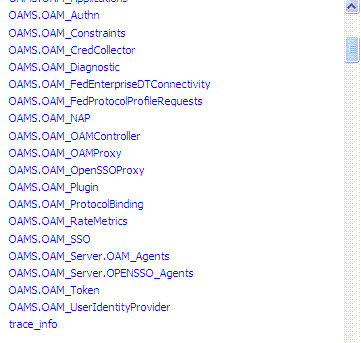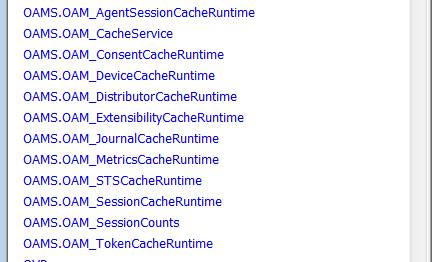11.5 Monitoring Metrics Using the DMS Console
Oracle Access Management uses the Oracle Dynamic Monitoring Systems (DMS) to measure application-specific performance information for OAM Servers and registered Agents. The metrics can be used to monitor the time spent in a particular area, or track particular occurrences or state changes.
To access the DMS console, type the following URL in a browser window and log in with your Oracle Access Management Administrator credentials.
http:// <example_AdminServer:Port/dms/Spy
Once logged into the DMS console you can monitor metrics as discussed in the following sections.
11.5.1 Monitoring OAM Metrics
Tthe OAM metrics can be reviewed In the DMS Metric Tables panel.
You can access metrics regarding OAM as illustrated in Figure 11-12. Click the desired metric from those listed to view the results on the right-side of the console.
11.5.2 Monitoring Coherence Caches
In the DMS Metric Tables panel, the Coherence metrics for each of the caches is available for review under the Weblogic Metrics section as illustrated in Figure 11-13. The metric table links in the section provide details about the cache operations.
11.5.3 Monitoring OpenSSO Proxy Metrics
This section provides the following topics:
11.5.3.1 Reviewing OpenSSO Metrics
User with valid Oracle Access Management Administrator credentials can view OpenSSO Proxy metrics in the DMS console.
Before you begin the procedure to access the DMS console, the OAM Server must be running.
11.5.3.2 OpenSSO Proxy Events and Metrics: Server
Throughput refers to the number of requests processed per second. Latency refers to the time required to process a particular request.
The Events that can be monitored are described in Table 11-3.
Table 11-3 OpenSSO Proxy Server Events
| Event | Description |
|---|---|
|
Naming Service Request |
This request is for naming lookups. One can monitor response time taken by the OpenSSO Proxy in servicing this request |
|
Agent Authentication Process |
Agent Authentication has been captured in two phases:
|
|
Agent Session Validation |
Agent Session Validation |
|
User Authentication |
This event is captured for Client SDK's only. One can monitor response time taken to authenticate client SDK's through this diagnostic event |
|
User Session Validation |
Time taken to validate User Session |
|
User Authorization |
Time taken for authorization as per the configured policy for the given resource |
Table 11-4 lists the various OpenSSO Proxy metrics available for the named server.
Table 11-4 OpenSSO Proxy Metrics: Server
| Metric | Description |
|---|---|
|
AgentAuthentication_Login |
Response time details for Authentication requests during login phase sent by the Agent to authenticate |
|
AgentAuthentication_LoginFailures |
Count of how many Agent Authentication requests during login phase have failed. |
|
AgentAuthentication_SubmitRequirements |
Response time details for Authentication requests during Submit Requirements phase send by the Agent to authenticate |
|
AgentAuthentication_SubmitRequirementsFailures |
Count of how many Agent Authentication requests during Submit Requirements phase have failed |
|
NamingServiceRequest |
Response time details for Naming Service Request operations |
|
NamingServiceRequestFailures |
Count of how many Naming Service Request operations have failed |
|
UserAuthentication_SDK |
Response time details for User Authentication requests |
|
UserAuthentication_SDKFailures |
Count of how many User authentication Requests have failed |
|
UserAuthorization |
Response time details for User Authorization operations |
|
UserAuthorizationFailures |
Count of how many user authorization operations have failed |
|
ValidateAgentSession |
Response time details for Agent Session Validation operation |
|
ValidateAgentSessionFailures |
Count of how many agent session validation operations have failed |
|
ValidateUserSession |
Response time details for User Session Validation operation |
|
ValidateUserSessionFailures |
Count of how many User session validation operations have failed. |
11.5.3.3 OpenSSO Proxy Metrics: Agent
OpenSSO Proxy metrics are available for each OpenSSO Agent.
Table 11-5 lists the OpenSSO Proxy metrics.
Table 11-5 OpenSSO Proxy Metrics: Agent
| Metric | Description |
|---|---|
|
AgentAuthentication_SubmitRequirements |
Response time details for Authentication requests during Submit Requirements phase collected per Agent |
|
AgentCacheMode |
Specifies the cache mode for the client policy evaluator. Values can be: subtree or self |
|
AgentFilterMode |
Specifies how the agent filters requests to protected web applications. The global value functions as a default, and applies for protected applications that do not have their own filter settings |
|
AgentHostName |
The host name of OpenSSO Agent |
|
AgentIPAddress |
The IP Address of OpenSSO Agent |
|
AgentMappingMode |
Specifies the mechanism used to determine the user ID |
|
AgentState |
The state of OpenSSO Agent: enabled or disabled. |
|
UserAttributeName |
Specifies the data store attribute that contains the user ID |
|
UserAuthorization |
Response time details for User Authorization operations collected per Agent |
|
UserIdentity |
Specifies the session property name for the authenticated user's ID. Default is 'UserToken' |
|
ValidateAgentSession |
Response time details for Agent Session Validation operation collected per Agent |
|
agentType |
The type of OpenSSO agent: J2EE or Web Agent |

